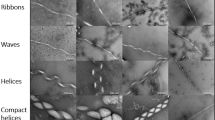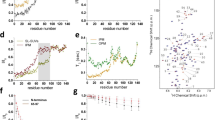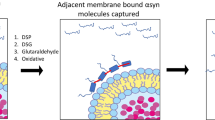Abstract
α-Synuclein (α-syn) is a 140-residue intrinsically disordered protein that is involved in neuronal and synaptic vesicle plasticity, but its aggregation to form amyloid fibrils is the hallmark of Parkinson's disease (PD). The interaction between α-syn and lipid surfaces is believed to be a key feature for mediation of its normal function, but under other circumstances it is able to modulate amyloid fibril formation. Using a combination of experimental and theoretical approaches, we identify the mechanism through which facile aggregation of α-syn is induced under conditions where it binds a lipid bilayer, and we show that the rate of primary nucleation can be enhanced by three orders of magnitude or more under such conditions. These results reveal the key role that membrane interactions can have in triggering conversion of α-syn from its soluble state to the aggregated state that is associated with neurodegeneration and to its associated disease states.
This is a preview of subscription content, access via your institution
Access options
Subscribe to this journal
Receive 12 print issues and online access
$259.00 per year
only $21.58 per issue
Buy this article
- Purchase on Springer Link
- Instant access to full article PDF
Prices may be subject to local taxes which are calculated during checkout






Similar content being viewed by others
References
Bellucci, A., Navarria, L., Zaltieri, M., Missale, C. & Spano, P. α-Synuclein synaptic pathology and its implications in the development of novel therapeutic approaches to cure Parkinson's disease. Brain Res. 1432, 95–113 (2012).
Bellucci, A. et al. From α-synuclein to synaptic dysfunctions: new insights into the pathophysiology of Parkinson's disease. Brain Res. 1476, 183–202 (2012).
Chiti, F. & Dobson, C.M. Protein misfolding, functional amyloid, and human disease. Annu. Rev. Biochem. 75, 333–366 (2006).
Dobson, C.M. Protein misfolding, evolution and disease. Trends Biochem. Sci. 24, 329–332 (1999).
Knowles, T.P., Vendruscolo, M. & Dobson, C.M. The amyloid state and its association with protein misfolding diseases. Nat. Rev. Mol. Cell Biol. 15, 384–396 (2014).
Spillantini, M.G. & Goedert, M. The α-synucleinopathies: Parkinson's disease, dementia with Lewy bodies, and multiple system atrophy. Ann. NY Acad. Sci. 920, 16–27 (2000).
Spillantini, M.G. et al. α-Synuclein in Lewy bodies. Nature 388, 839–840 (1997).
Bodner, C.R., Dobson, C.M. & Bax, A. Multiple tight phospholipid-binding modes of α-synuclein revealed by solution NMR spectroscopy. J. Mol. Biol. 390, 775–790 (2009).
Davidson, W.S., Jonas, A., Clayton, D.F. & George, J.M. Stabilization of α-synuclein secondary structure upon binding to synthetic membranes. J. Biol. Chem. 273, 9443–9449 (1998).
Fusco, G. et al. Direct observation of the three regions in α-synuclein that determine its membrane-bound behaviour. Nat. Commun. 5, 3827 (2014).
Middleton, E.R. & Rhoades, E. Effects of curvature and composition on α-synuclein binding to lipid vesicles. Biophys. J. 99, 2279–2288 (2010).
Ouberai, M.M. et al. α-Synuclein senses lipid packing defects and induces lateral expansion of lipids leading to membrane remodeling. J. Biol. Chem. 288, 20883–20895 (2013).
Shvadchak, V.V., Yushchenko, D.A., Pievo, R. & Jovin, T.M. The mode of α-synuclein binding to membranes depends on lipid composition and lipid to protein ratio. FEBS Lett. 585, 3513–3519 (2011).
Trexler, A.J. & Rhoades, E. α-Synuclein binds large unilamellar vesicles as an extended helix. Biochemistry 48, 2304–2306 (2009).
Abeliovich, A. et al. Mice lacking α-synuclein display functional deficits in the nigrostriatal dopamine system. Neuron 25, 239–252 (2000).
Clayton, D.F. & George, J.M. The synucleins: a family of proteins involved in synaptic function, plasticity, neurodegeneration and disease. Trends Neurosci. 21, 249–254 (1998).
Fortin, D.L., Nemani, V.M., Nakamura, K. & Edwards, R.H. The behavior of α-synuclein in neurons. Mov. Disord. 25 (suppl. 1): S21–S26 (2010).
Gureviciene, I., Gurevicius, K. & Tanila, H. Role of α-synuclein in synaptic glutamate release. Neurobiol. Dis. 28, 83–89 (2007).
Nemani, V.M. et al. Increased expression of α-synuclein reduces neurotransmitter release by inhibiting synaptic vesicle reclustering after endocytosis. Neuron 65, 66–79 (2010).
Auluck, P.K., Caraveo, G. & Lindquist, S. α-Synuclein: membrane interactions and toxicity in Parkinson′s disease. Annu. Rev. Cell Dev. Biol. 26, 211–233 (2010).
Butterfield, S.M. & Lashuel, H.A. Amyloidogenic protein-membrane interactions: mechanistic insight from model systems. Angew. Chem. Int. Edn Engl. 49, 5628–5654 (2010).
Fink, A.L. The aggregation and fibrillation of α-synuclein. Acc. Chem. Res. 39, 628–634 (2006).
Giehm, L., Svergun, D.I., Otzen, D.E. & Vestergaard, B. Low-resolution structure of a vesicle disrupting α-synuclein oligomer that accumulates during fibrillation. Proc. Natl. Acad. Sci. USA 108, 3246–3251 (2011).
Martinez, Z., Zhu, M., Han, S. & Fink, A.L. GM1 specifically interacts with α-synuclein and inhibits fibrillation. Biochemistry 46, 1868–1877 (2007).
Zhu, M. & Fink, A.L. Lipid binding inhibits α-synuclein fibril formation. J. Biol. Chem. 278, 16873–16877 (2003).
Hellstrand, E., Nowacka, A., Topgaard, D., Linse, S. & Sparr, E. Membrane lipid co-aggregation with α-synuclein fibrils. PLoS ONE 8, e77235 (2013).
Cohen, S.I., Vendruscolo, M., Dobson, C.M. & Knowles, T.P. From macroscopic measurements to microscopic mechanisms of protein aggregation. J. Mol. Biol. 421, 160–171 (2012).
Cohen, S.I. et al. Nucleated polymerization with secondary pathways. I. Time evolution of the principal moments. J. Chem. Phys. 135, 065105 (2011).
Knowles, T.P. et al. An analytical solution to the kinetics of breakable filament assembly. Science 326, 1533–1537 (2009).
Takamori, S. et al. Molecular anatomy of a trafficking organelle. Cell 127, 831–846 (2006).
Dedmon, M.M., Lindorff-Larsen, K., Christodoulou, J., Vendruscolo, M. & Dobson, C.M. Mapping long-range interactions in α-synuclein using spin-label NMR and ensemble molecular dynamics simulations. J. Am. Chem. Soc. 127, 476–477 (2005).
Zhu, M., Li, J. & Fink, A.L. The association of α-synuclein with membranes affects bilayer structure, stability, and fibril formation. J. Biol. Chem. 278, 40186–40197 (2003).
Cabaleiro-Lago, C., Quinlan-Pluck, F., Lynch, I., Dawson, K.A. & Linse, S. Dual effect of amino modified polystyrene nanoparticles on amyloid β protein fibrillation. ACS Chem Neurosci 1, 279–287 (2010).
Lentz, B.R. Use of fluorescent probes to monitor molecular order and motions within liposome bilayers. Chem. Phys. Lipids 64, 99–116 (1993).
Nuscher, B. et al. α-Synuclein has a high affinity for packing defects in a bilayer membrane: a thermodynamics study. J. Biol. Chem. 279, 21966–21975 (2004).
Buell, A.K. et al. Solution conditions determine the relative importance of nucleation and growth processes in α-synuclein aggregation. Proc. Natl. Acad. Sci. USA 111, 7671–7676 (2014).
Cohen, S.I. et al. Proliferation of amyloid-β42 aggregates occurs through a secondary nucleation mechanism. Proc. Natl. Acad. Sci. USA 110, 9758–9763 (2013).
Meisl, G. et al. Differences in nucleation behavior underlie the contrasting aggregation kinetics of the Aβ40 and Aβ42 peptides. Proc. Natl. Acad. Sci. USA 111, 9384–9389 (2014).
Ferrone, F. Analysis of protein aggregation kinetics. Methods Enzymol. 309, 256–274 (1999).
Ferrone, F.A., Hofrichter, J. & Eaton, W.A. Kinetics of sickle hemoglobin polymerization. II. A double nucleation mechanism. J. Mol. Biol. 183, 611–631 (1985).
Oosawa, F. & Kasai, M. A theory of linear and helical aggregations of macromolecules. J. Mol. Biol. 4, 10–21 (1962).
Xue, W.F., Homans, S.W. & Radford, S.E. Systematic analysis of nucleation-dependent polymerization reveals new insights into the mechanism of amyloid self-assembly. Proc. Natl. Acad. Sci. USA 105, 8926–8931 (2008).
Campioni, S. et al. The presence of an air-water interface affects formation and elongation of α-synuclein fibrils. J. Am. Chem. Soc. 136, 2866–2875 (2014).
Giehm, L., Lorenzen, N. & Otzen, D.E. Assays for α-synuclein aggregation. Methods 53, 295–305 (2011).
Giehm, L. & Otzen, D.E. Strategies to increase the reproducibility of protein fibrillization in plate reader assays. Anal. Biochem. 400, 270–281 (2010).
Oosawa, F. Thermodynamics of the Polymerization of Protein (Academic Press, 1975).
Cremades, N. et al. Direct observation of the interconversion of normal and toxic forms of α-synuclein. Cell 149, 1048–1059 (2012).
Bishop, M.F. & Ferrone, F.A. Kinetics of nucleation-controlled polymerization. A perturbation treatment for use with a secondary pathway. Biophys. J. 46, 631–644 (1984).
Wilhelm, B.G. et al. Composition of isolated synaptic boutons reveals the amounts of vesicle trafficking proteins. Science 344, 1023–1028 (2014).
Ciryam, P., Tartaglia, G.G., Morimoto, R.I., Dobson, C.M. & Vendruscolo, M. Widespread aggregation and neurodegenerative diseases are associated with supersaturated proteins. Cell Rep. 5, 781–790 (2013).
Hoyer, W. et al. Dependence of α-synuclein aggregate morphology on solution conditions. J. Mol. Biol. 322, 383–393 (2002).
Petrache, H.I. et al. Structure and fluctuations of charged phosphatidylserine bilayers in the absence of salt. Biophys. J. 86, 1574–1586 (2004).
Baldwin, A.J. et al. Metastability of native proteins and the phenomenon of amyloid formation. J. Am. Chem. Soc. 133, 14160–14163 (2011).
Weinreb, P.H., Zhen, W., Poon, A.W., Conway, K.A. & Lansbury, P.T. Jr. NACP, a protein implicated in Alzheimer′s disease and learning, is natively unfolded. Biochemistry 35, 13709–13715 (1996).
Buell, A.K. et al. Frequency factors in a landscape model of filamentous protein aggregation. Phys. Rev. Lett. 104, 228101 (2010).
Wales, D.J. & Doye, J.P.K. Global optimization by basin-hopping and the lowest energy structures of Lennard-Jones clusters containing up to 110 atoms. J. Phys. Chem. A 101, 5111–5116 (1997).
Smith, J.F., Knowles, T.P., Dobson, C.M., Macphee, C.E. & Welland, M.E. Characterization of the nanoscale properties of individual amyloid fibrils. Proc. Natl. Acad. Sci. USA 103, 15806–15811 (2006).
Acknowledgements
We wish to thank M. Ouberai for her help with the preparation of SUVs and for valuable discussions along with C. Waudby and J. Christodoulou. This work was supported by the UK Biotechnology and Biochemical Sciences Research Council (BB/H003843/1 to C.M.D. and M.V.); the Wellcome Trust (094425/Z/10/Z to C.M.D., T.P.J.K. and M.V.); the European Research Council (337969, T.P.J.K.); the Frances and Augustus Newman Foundation (T.P.J.K.); Magdalene College, Cambridge (A.K.B.); St John's College, Cambridge (T.C.T.M.); the Cambridge Home and EU Scholarship Scheme (G.M.); Elan Pharmaceuticals (C.M.D., T.P.J.K., M.V., C.G. and A.K.B.) and the Leverhulme Trust (A.K.B.).
Author information
Authors and Affiliations
Contributions
C.G. performed the experiments and A.K.B. recorded the AFM images. C.G., A.K.B., T.P.J.K., M.V. and C.M.D. were involved in the design of the study. C.G., A.K.B., G.M. and C.M.D. wrote the paper, and all the authors were involved in the analysis of the data and editing of the paper.
Corresponding author
Ethics declarations
Competing interests
The authors declare no competing financial interests.
Supplementary information
Supplementary Text and Figures
Supplementary Results and Supplementary Figures 1–6. (PDF 900 kb)
Rights and permissions
About this article
Cite this article
Galvagnion, C., Buell, A., Meisl, G. et al. Lipid vesicles trigger α-synuclein aggregation by stimulating primary nucleation. Nat Chem Biol 11, 229–234 (2015). https://doi.org/10.1038/nchembio.1750
Received:
Accepted:
Published:
Issue Date:
DOI: https://doi.org/10.1038/nchembio.1750
This article is cited by
-
Mass photometric detection and quantification of nanoscale α-synuclein phase separation
Nature Chemistry (2023)
-
The interface of condensates of the hnRNPA1 low-complexity domain promotes formation of amyloid fibrils
Nature Chemistry (2023)
-
Mechanisms and pathology of protein misfolding and aggregation
Nature Reviews Molecular Cell Biology (2023)
-
Fibril formation and ordering of disordered FUS LC driven by hydrophobic interactions
Nature Chemistry (2023)
-
α-Synuclein fibril and synaptic vesicle interactions lead to vesicle destruction and increased lipid-associated fibril uptake into iPSC-derived neurons
Communications Biology (2023)



